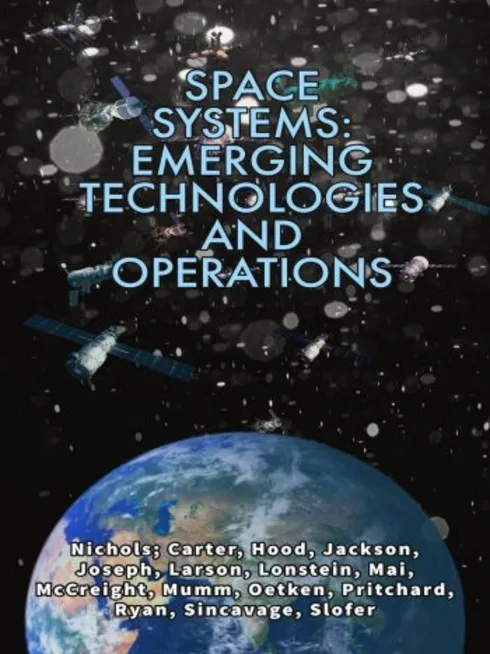
Space Systems: Emerging Technologies and Operations
No ratings
Randall K. Nichols, Kansas State University
Hans C. Mumm, California University of Pennsylvania
Wayne D. Lonstein, Pennsylvania State University
Julie J.C.H Ryan, Wyndrose Technical Group
Candice M. Carter, NASA
Copyright Year:
Last Update: 2024
Publisher: New Prairie Press
Language: English
Formats Available
Conditions of Use
![]() Attribution-NonCommercial-ShareAlike
Attribution-NonCommercial-ShareAlike
CC BY-NC-SA
Table of Contents
- Front Matter
- Foreword
- Chapter 1 - Current State of Space Operations
- Chapter 2 - Satellite Killers and Hypersonic Drones
- Chapter 3 - Space Electronic Warfare, Signal Interception, ISR, Jamming, Spoofing, & ECD
- Chapter 4 - Manufacturing in Space
- Chapter 5 - Exploration of Key Infrastructure Vulnerabilities from Space-Based Platforms
- Chapter 6 - Trash Collection and Tracking in Space
- Chapter 7 - Leveraging Space for Disaster Risk Reduction & Management
- Chapter 8 - Bio-treats to Agriculture-Solutions from Space
- Chapter 9 - Modeling, Simulations, & Extended Reality
- Chapter 10 - Drones & Precision Agricultural Mapping
- Chapter 11 - Civilian use of Space for Environmental, Wildlife Tracking, & Fire Risk Zone ID
- Chapter 12 - Humanitarian Use of Space Technologies to Improve Global Food Supply &Catte Management
About the Book
SPACE SYSTEMS: EMERGING TECHNOLOGIES AND OPERATIONS (SSETO) is our seventh textbook in a series covering the world of UASs / CUAS / UUVs. SSETO takes on a new purview of SPACE. UASs (Drones) have a maximum altitude of about 33,000 ft (10 km) because rotating rotors become physically limiting. (Nichols R. et al., 2019) Between 400 ft and 33,000 ft is in the purview of DREAMERS. In the DREAMERS region, Space has its most interesting technological emergence. We see emerging technologies and operations that may have profound effects on humanity. This is the mission our book addresses. We look at the Dreamer region from three perspectives: 1) a Military view where intelligence, jamming, spoofing, advanced materials, and hypersonics are in play; 2) the Operational Dreamer Region; which includes Space-based platform vulnerabilities, trash, disaster recovery management, A.I., manufacturing, and extended reality; and 3) the Humanitarian Use of Space technologies; which includes precision agriculture wildlife tracking, fire risk zone identification, and improving the global food supply and cattle management. State-of-the-Art research by a team of fifteen SMEs is incorporated into our book. We trust you will enjoy reading it as much as we have in its writing. There is hope for the future.
About the Contributors
Authors
Randall K. Nichols is a Professor of Practice in Unmanned Aircraft Systems (UAS)– Cybersecurity at Kansas State University Aerospace and Technology Campus in Salina, Kansas. Nichols serves as Director, GC Aerospace Cyber Operations program. Nichols is internationally respected, with 52 years of experience in leadership roles in cryptography, counterintelligence, counterterrorism, INFOSEC, UAS/ CUAS/UUV and sensitive computer applications. Throughout his career, Nichols has published fourteen bestselling textbooks. Nichols has provided counsel to the United States government and is certified as a federal subject matter expert (SME) in cryptography and computer forensics. His most recent work involves creating masters and certificate graduate-level programs for KSU and Utica College.
Dr. Mumm has spent a combined twenty-eight years in government and contractor service building teams to address hard problems in the areas of national security, homeland security, and advanced technologies. He was the Division Chief for Cyber Security at the Office of The Director of National Intelligence (ODNI) programming and executing a budget of over $140M. Subsequently, he accepted a Branch Chief position with the CIA and built a unique set of continuous monitoring capabilities in support of the ICD503 Risk Management Framework. His achievements include establishing a rogue wireless framework, as well as the funding, technology, and teams to support the ICD 503 initiatives. His programmatic responsibilities included the auditable financial statements of assigned programs, the long-range planning for next-generation systems included tracking working capital funds through the CBJB and POM submissions.
Wayne Lonstein holds a Bachelor of Arts Degree in Political Science from Wilkes University, a Bachelor of Science Degree in Cyber Forensics, and Information Security from Syracuse University– Utica College, A Master of Science Degree in Homeland Security with a concentration in Information Security from The Pennsylvania State University and a Juris Doctor Degree from Pace University School of Law. Additionally, he holds a CISSP Certification from The Pennsylvania State University. He is a member of the state bars of New York, New Jersey, Massachusetts, and Pennsylvania, as well as being admitted to over 30 United States District Court Bars, The Court of Veterans Appeals, the United States Tax Court, and the bar of the United States Court of Appeals of the 2nd, 3rd, and 5th Circuits.
Julie J.C.H. Ryan, D.Sc., is the CEO of Wyndrose Technical Group, having retired from academia in 2017. Her last position in academia was Professor of Cybersecurity and Information Assurance at the U.S. National Defense University. Before that, she was tenured faculty at George Washington University and a visiting scholar at the National Institute for Standards and Technology (NIST).
Prof. Candice Carter is a cybersecurity expert with over 15 years of hands-on experience in counterterrorism, counterintelligence, and cybercriminal investigations. She conducts Classified/Unclassified briefings in the areas of Terroristic Cyber Capabilities using Social Media and Counterterrorism for the Intelligence Community (IC). Ms. Carter conducts research and constructs Asymmetric Warfare and Attack / Defense Scenarios against National Critical Infrastructure. She is the Team Lead for NASA Aeronautics Research Institute for Transformative Vertical Flight (TVF) CommercialIntra-City On-DemandVTOLgroup.Ms.Carter is an invited speaker for key organizations, including BSides London and (ISC)2 Security Congress. She is an Assistant Professor/Chair MSc Cybersecurity program at Wilmington University. Ms. Carter holds an MSc in Cybersecurity Forensics and Intelligence from Utica College, Utica, NY, and a PMT Cybersecurity UAS from Kansas State University.
